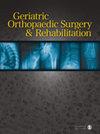针对股骨颈骨折的三种套筒螺钉配置的生物力学研究:有限元分析
IF 1.6
4区 医学
Q4 GERIATRICS & GERONTOLOGY
引用次数: 0
摘要
背景为了提高套管螺钉(CS)在治疗股骨颈骨折(FNF)中的性能,人们提出了许多新的螺钉结构。然而,大多数研究仅分析了不同螺钉结构在静态条件下的生物力学性能。方法在这项有限元分析研究中,采用了九个股骨近端数值模型来分析不同骨折类型和不同固定策略(分别为三个倒三角形平行套管螺钉(TCS)、四个非平行套管螺钉(FCS)和双平面双支撑螺钉固定(BDSF))的机械响应。结果 在 Pauwels I 和 II 型骨折中,FCS 的股骨近端最大主应变(MPS)峰值最低,而 BDSF 的 MPS 峰值最高。在 Pauwels III 型骨折中,BDSF 的 MPS 性能有所改善,在部分加载条件下优于 FCS。在所有骨折类型中,FCS 在所有加载条件下均表现出最低的 von Mises 应力,表明螺钉断裂的风险最小。而 BDSF 在治疗 Pauwels III 型 FNF 方面显示出了潜力。本文章由计算机程序翻译,如有差异,请以英文原文为准。
Biomechanical Study of Three Cannulated Screws Configurations for Femur Neck Fracture: A Finite Element Analysis.
Background
To improve the performance of cannulated screws (CSs) in the treatment of femoral neck fractures (FNF), a number of new screw configurations have been proposed. However, most of the studies have only analyzed the biomechanical performance of different screw configurations under static conditions. This study aimed to investigate the biomechanical performance of three cannulated screws configurations under different loadings through finite element analysis.
Methods
In this FEA study, nine numerical models of proximal femur were employed to analyze the mechanical response of various fracture types and different fixation strategies (three inverted triangular parallel cannulated screws (TCS), four non-parallel cannulated screws (FCS) and biplane double-supported screw fixation (BDSF) respectively). The maximum principal strain (MPS) on the proximal femur and the von Mises stress on the screws were compared for different models.
Results
In Pauwels I and II fractures, FCS had the lowest peak MPS on the proximal femur and the BDSF had highest peak MPS value. In Pauwels III fractures, BDSF performance in MPS is improved and better than FCS under partial loading conditions. FCS exhibits the lowest von Mises stress in all load conditions for all fracture types, demonstrating minimal risk of screws breakage.
Conclusions
FCS is an ideal screw configuration for the treatment of FNF. And BDSF has shown potential in the treatment of Pauwels type III FNF.
求助全文
通过发布文献求助,成功后即可免费获取论文全文。
去求助
来源期刊

Geriatric Orthopaedic Surgery & Rehabilitation
Medicine-Rehabilitation
CiteScore
3.00
自引率
0.00%
发文量
80
审稿时长
9 weeks
期刊介绍:
Geriatric Orthopaedic Surgery & Rehabilitation (GOS) is an open access, peer-reviewed journal that provides clinical information concerning musculoskeletal conditions affecting the aging population. GOS focuses on care of geriatric orthopaedic patients and their subsequent rehabilitation. This journal is a member of the Committee on Publication Ethics (COPE).
 求助内容:
求助内容: 应助结果提醒方式:
应助结果提醒方式:


